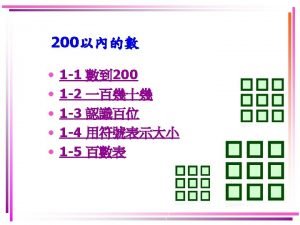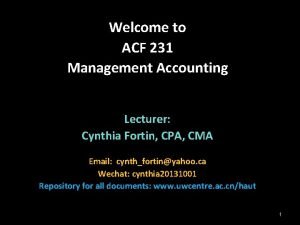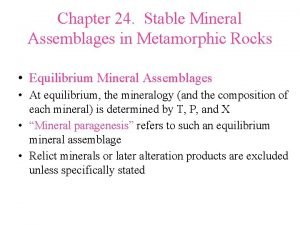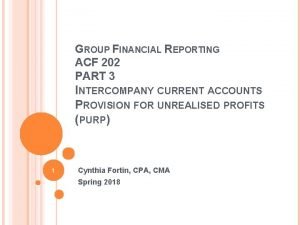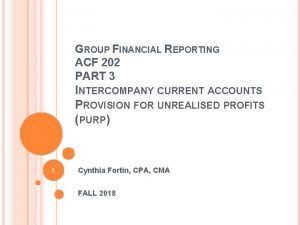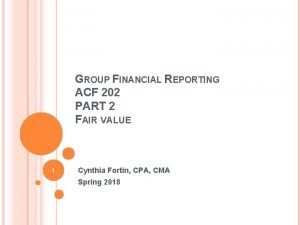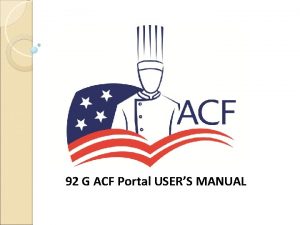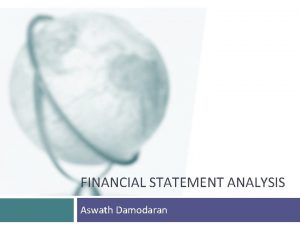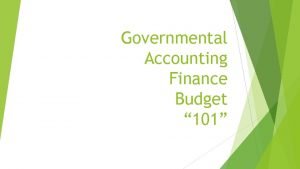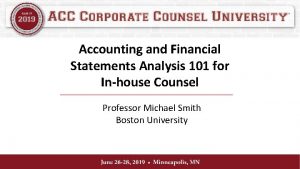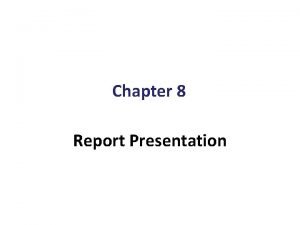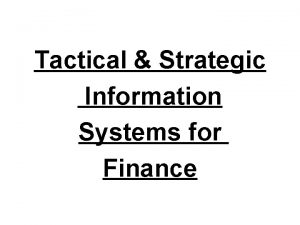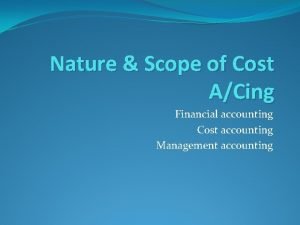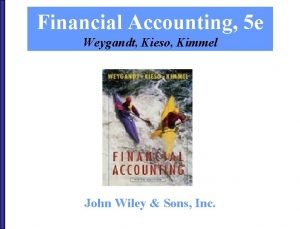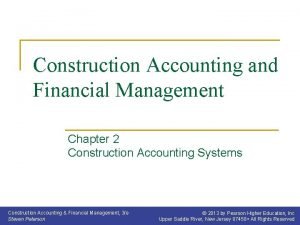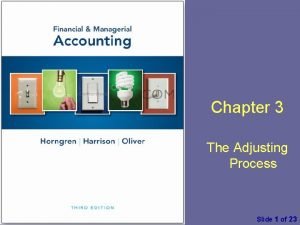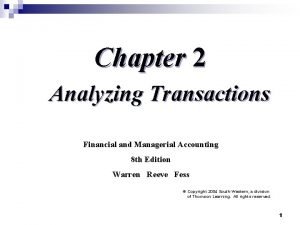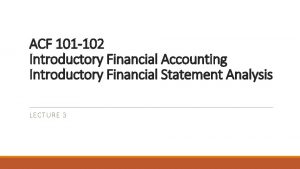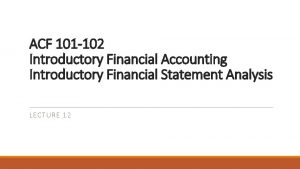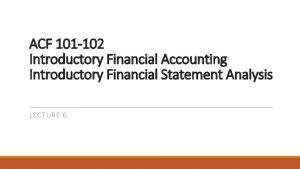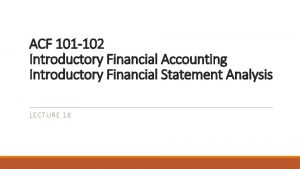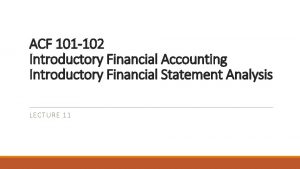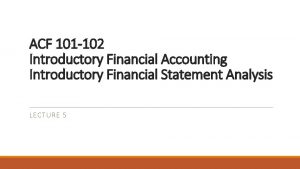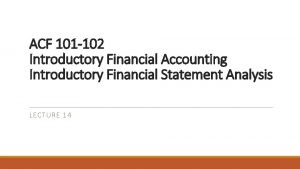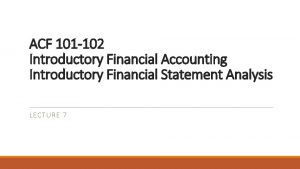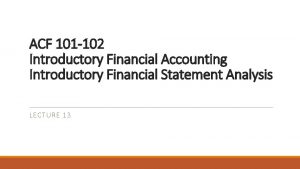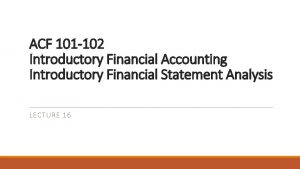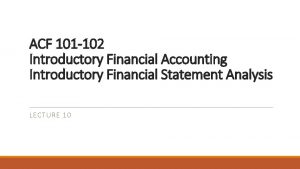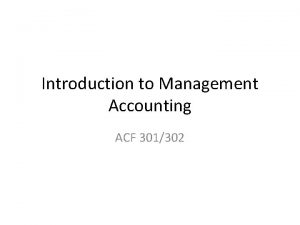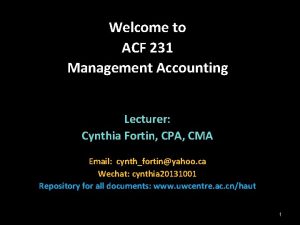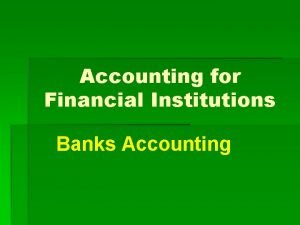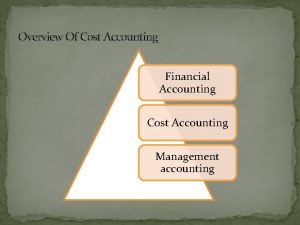ACF 101 102 Introductory Financial Accounting Introductory Financial































- Slides: 31

ACF 101 -102 Introductory Financial Accounting Introductory Financial Statement Analysis LECTURE 1

Learning Outcome Describe the role and function of external financial reports and identify their users Prepare basic Financial Statements

Topics Accounting and decision making Users of accounting information The Balance Sheet Income Statement Accounting Equation

Introduction to Accounting and applications of accounting in financial reports and financial analysis

Accounting and Decision-Making Accounting – the process of identifying, recording, summarizing, and reporting economic information to decision makers

Types of Accounting: ◦Tax – primarily used by the government ◦Non-Profit (donors, governments) ◦Managerial – insiders (budgets, planning, costing, pricing, managing product mix, etc. ) ◦Financial – outsiders (owners, creditors, suppliers, regulators, unions, others)

Principal Components of Annual Financial Reports ◦ A letter from corporate management ◦ Management’s discussion and analysis of past and possible future transactions, events, circumstances ◦ Financial statements ◦ Footnotes explaining many elements of the financial statements in more detail ◦ Independent auditor’s report ◦ A statement of management’s responsibility for preparation of the financial statements ◦ Other corporate information

Sequence of Events Leading to Financial Statements Found in Those Reports (Process) 1. Measurable economic event occurs 2. Private (work for the reporting entity) bookkeepers/accountants analyze event to determine what elements/accounts are affected, then record the event into records 3. Records are summarized into financial statements 4. Financial reports that include the statements are provided to users who make decisions

Characteristics of Financial Reports ◦Prepared by management ◦Provided to outsiders quarterly and annually ◦Primarily about past transactions and events ◦Tell very little about future transactions, events, or circumstances

Financial Statements ◦Balance Sheet ◦Income Statement ◦Statement of Cash Flows ◦Statement of Stockholders’ Equity

Explain how accounting information assists in making decisions…. .

Accounting is the language of business and is the process of identifying, recording, summarizing, and reporting economic information to decision makers.

Who are the decision makers?

Decision makers use this information to answer questions concerning investment alternatives, product development, employee evaluations, loan levels, and cash needs.

Financial accounting concentrates on the external decision maker versus managerial accounting, which serves internal decision makers.

Financial accounting answers the questions of financial strength and performance through the use of three major financial statements: balance sheet, income statement, and the statement of cash flows.

The annual report is usually the source management uses to present these statements as well as other financial information. It is prepared by management to inform investors about the company's past performance and future prospects.

Annual reports are also sometimes used to promote the company and communicate its message.

Accessing Financial Reports and Statements ◦ Available to all via the Internet from company’s website ◦ Formally sent or made available to owners ◦ Formally filed with the Government US- (SEC-Securities and Exchange Commission) UK- (HMRC- Her Majesty’s Revenue & Customs)

The Balance Sheet The balance sheet (also called the statement of financial position) shows the financial status of a company at a particular instant in time Reflects the basic accounting equation, which is Resources = Claims against those resources Assets = Liabilities + Owners’ equity

Assets – economic resources that the company owns or controls from past transactions/events that it expects to help generate future benefits

The Balance Sheet Accounts – subdivision of the element Assets ◦ Cash and cash equivalents ◦ Accounts Receivable (Customer bought it on credit) ◦ Inventories (Merchandise, Supplies, Parts) ◦ Prepaid Expenses (taxes, utilities, insurance) ◦ Property ◦ Plant ◦ Equipment Current Assets Long-term Assets

Liabilities – economic obligations of the organization to outsiders from past transactions /events that it expects to pay in the future

The Balance Sheet Accounts – subdivision of the element Liabilities ◦Accounts Payable (We bought it on credit) ◦Notes Payable ◦Long-term debt

Owners’ equity is the owners’ claim on the organization’s assets, i. e. , assets minus liabilities

The Balance Sheet Accounts – subdivision of the element Equity ◦ Sole Proprietorships - XX Capital – Partnerships - YY Capital ◦ Corporations - Capital (Common) Stock - Paid in Capital in excess of par/stated value

Preparing the Balance Sheet

Income Statement Income – increase in wealth over time Basic accounting equation + specific accounts ASSETS = Cash Accounts Receivable Prepaid items Equipment Building Land LIABILITIES + Accounts Payable Notes Payable OWNERS’ EQUITY Paid in Capital Retained Earnings Revenue Expenses Gains (later) Losses (later) Distributions to owners Dividends

Income Statement Balance sheet - financial position/condition at discrete points in time, e. g. fiscal year end Income statement (Statement of Earnings, Operations, Profit and Loss) - changes that took place between those points in time attributable to operating the business Revenues Expenses Gains/Loses (later) Net income (loss)

Income Statement Balance Sheet December 31 20 X 1 Balance Sheet February 28 20 X 2 Balance Sheet January 31 20 X 2 Income Statement For January Income Statement For February Balance Sheet March 31 20 X 2 Income Statement For March Time Income Statement for Quarter Ended March 31, 20 X 2

Income Statement Dynamics (ethical dilemmas) ◦ Interpreting economic events/preparing financial reports requires judgment ◦ Management ◦ Exercises that judgment ◦ Is rewarded on the reports’ content ◦ Circumstances have, do, and will occur where ◦ Honest disagreements occur ◦ Window dressing opportunities will tempt some ◦ A few will go too far and commit illegal acts
 101 102 103
101 102 103 Prime numbers 1-200 chart
Prime numbers 1-200 chart Financial accounting and accounting standards chapter 1
Financial accounting and accounting standards chapter 1 Management accounting vs financial accounting ppt
Management accounting vs financial accounting ppt Acf 231
Acf 231 3m acf
3m acf Army cadets values and standards
Army cadets values and standards Acf certification levels
Acf certification levels Army cadet force values and standards powerpoint
Army cadet force values and standards powerpoint Acf and akf diagrams
Acf and akf diagrams Aws academy cloud foundations (acf)
Aws academy cloud foundations (acf) Intercompany margin
Intercompany margin Purp in accounting
Purp in accounting Acf 202
Acf 202 Acf portal
Acf portal Acf ncf
Acf ncf Acf formula
Acf formula Aswath damodaran accounting
Aswath damodaran accounting Finance topics for discussion
Finance topics for discussion Financial analysis 101
Financial analysis 101 Aasb 101 presentation of financial statements
Aasb 101 presentation of financial statements Objectives of computerized accounting
Objectives of computerized accounting Conservatism accounting principle
Conservatism accounting principle Tactical accounting
Tactical accounting Accounting statement of financial position
Accounting statement of financial position Scope management accounting
Scope management accounting Scope of cost accounting
Scope of cost accounting The nature of management accounting
The nature of management accounting Kimmel accounting tools 5e
Kimmel accounting tools 5e Construction accounting basics
Construction accounting basics Income statement in financial accounting
Income statement in financial accounting Financial accounting chapter 2 solutions
Financial accounting chapter 2 solutions
